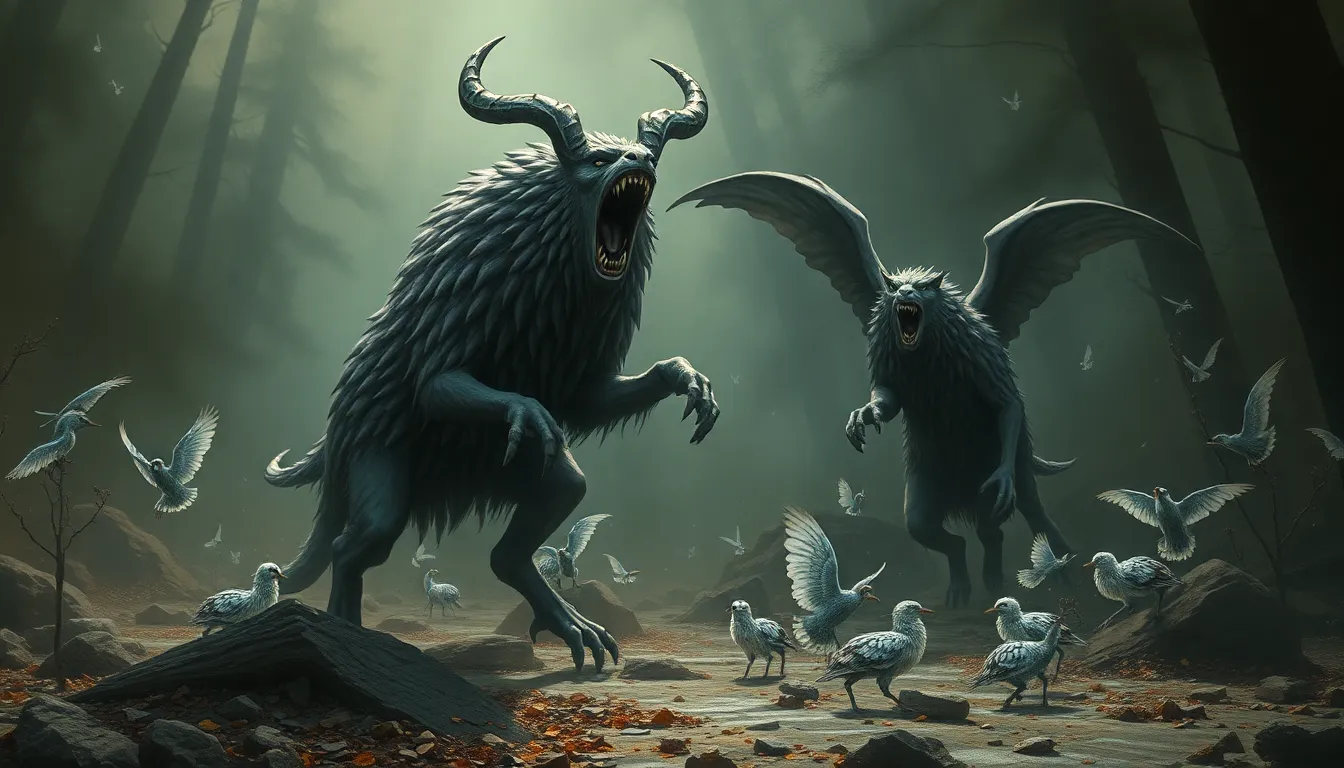The Influence of Baltic Mythology on Folk Medicine and Healing Practices
The Baltic region, encompassing Latvia, Lithuania, and Estonia, boasts a rich tapestry of myths and legends that have shaped its cultural identity for centuries. These ancient stories, passed down through generations, offer a glimpse into the spiritual beliefs and practices of the Baltic people, shedding light on their understanding of the natural world and its connection to human health and well-being. Baltic mythology, woven into the very fabric of folklore and tradition, has profoundly influenced folk medicine and healing practices, providing a framework for understanding illness, healing rituals, and the role of nature in restoring balance to the body and spirit.
1. The World of Baltic Mythology: A Tapestry of Spirits and Deities
Baltic mythology paints a vibrant picture of a world teeming with spirits, deities, and supernatural beings, each with its unique role in the natural order. Central to this belief system is the interconnectedness of humans and nature, where every element, from the wind and the rain to the trees and the animals, possesses a spirit or a deity that governs its power. Nature spirits, known as "dabas gari" in Latvian, are believed to inhabit forests, fields, rivers, and mountains, their presence felt in the rustling leaves, the flowing water, and the whisper of the wind. These benevolent spirits, often associated with specific locations or natural phenomena, are revered as protectors of the land and its inhabitants.
Beyond these nature spirits, the Baltic pantheon includes a cast of powerful gods and goddesses, each embodying specific aspects of nature and human life. Among them are Dievs, the supreme god, representing the sky and the sun, and Laima, the goddess of fate and destiny, who guides the course of individual lives. These deities are not merely abstract concepts but are seen as active participants in human affairs, capable of bestowing blessings, offering guidance, but also inflicting curses or misfortune. This belief in divine intervention permeates Baltic mythology and has influenced folk medicine, with many health issues attributed to the displeasure of certain deities or the influence of malevolent spirits.
The Baltic people also held a deep reverence for sacred groves and springs, believed to be portals to the spiritual realm, where humans could connect with the divine and seek healing. These sacred sites, often marked by ancient trees or springs with healing properties, were places of pilgrimage and worship, offering a space for prayer, offerings, and rituals aimed at restoring balance and well-being.
2. Healing through Connection: The Importance of Harmony with Nature
The core belief of Baltic mythology is the interconnectedness of humans and nature. The human soul, referred to as "dvēsele" in Latvian, is seen as a reflection of the natural world, with its well-being intimately tied to the state of harmony with nature. This belief underpins the philosophy of Baltic folk medicine, where illness is often viewed as a disruption of this natural harmony, a result of disharmony with the forces of nature or a transgression against the spirits that govern the land.
Baltic folk medicine emphasizes the importance of living in accordance with the rhythms of nature, respecting its cycles and forces. This includes practices such as avoiding unnecessary harm to the natural world, offering gratitude for its bounty, and seeking guidance from nature spirits and deities through rituals and offerings. A key element of this philosophy is the belief that the natural world holds within it the power to heal, with plants and herbs regarded as divine gifts for restoring balance and well-being.
3. Rituals and Practices: Invoking the Healing Power of Mythology
Baltic mythology provides a rich repertoire of rituals and practices designed to invoke the healing power of the supernatural realm. These practices, often passed down through generations, reflect the understanding that illness can be influenced by spiritual forces and that healing requires not only physical treatment but also spiritual intervention.
One of the most common practices in Baltic folk medicine is the use of incantations and charms, believed to possess the power to ward off illness or influence the spirits that cause it. These words, spoken with intention and often incorporating elements of mythology and folklore, act as weapons against disease, serving as a bridge between the physical and spiritual realms. Another essential element of Baltic healing rituals is the practice of offering food, drink, or precious items to appease or thank the spirits. These offerings, often left at sacred groves or springs, are believed to foster a positive relationship with the spirits, ensuring their protection and favour.
Ritualistic baths and cleansing practices are also prominent in Baltic folk medicine, embodying the belief that water, a potent symbol of purification in many cultures, can wash away illness and cleanse the body of harmful spiritual influences.
4. The Role of the Healer: Shamanistic Wisdom and Tradition
The role of the healer in Baltic folk medicine is deeply intertwined with the understanding of mythology and the spiritual realm. These healers, often referred to as "zinātnīks" in Latvian, are not merely healers of the body but also interpreters of mythology and tradition, possessing a deep understanding of the spiritual forces that influence health. They act as mediators between the human world and the supernatural realm, consulting the spirits through rituals, dreams, and visions.
Dreams and visions are particularly significant in Baltic folk medicine, often revealing insights into the source of illness, the spirits involved, and the appropriate course of treatment. Healers are trained to interpret these dreams and visions, drawing upon traditional knowledge passed down through generations, using them to guide their healing practices. The transmission of knowledge and the preservation of tradition are central to the healing role. Much of the knowledge of Baltic folk medicine has been passed down orally, with stories, legends, and healing practices forming a living archive of wisdom, ensuring the continuity of tradition.
5. Mythological Creatures and their Symbolic Significance in Healing
Baltic mythology is populated with a diverse cast of creatures, each with its symbolic significance and role in the understanding of health and healing. These creatures, often embodying specific powers or qualities, are incorporated into folk medicine, serving as metaphors for the spiritual forces at work in illness and healing.
The "Laumiņa" (Little Spirit), a benevolent nature spirit often depicted as a small, beautiful creature, is particularly revered in Baltic folk medicine. These spirits are associated with the protection of children and their well-being, believed to watch over infants and ensure their healthy growth and development. The "Ragana" (Witch), a figure often feared in other cultures, is viewed differently in Baltic mythology. While capable of wielding powerful magic, witches are not always malevolent. They are often associated with the understanding of herbs and their medicinal properties, with their knowledge considered valuable in healing practices.
The "Jūras Vecītis" (Old Man of the Sea), a powerful deity residing in the depths of the ocean, holds a significant place in Baltic folk medicine, particularly regarding sea-based healing practices. This deity is believed to possess the power to heal ailments related to the sea, such as sea sickness or injuries sustained at sea, and rituals involving offerings to the "Jūras Vecītis" are often performed to seek his intervention. These mythical figures, embedded in the fabric of Baltic culture, provide a rich tapestry of symbolism, influencing the understanding of illness and healing, shaping the practices of folk medicine for generations.
6. The Influence of Baltic Mythology on Contemporary Folk Medicine
The influence of Baltic mythology on folk medicine continues to be felt in the 21st century, with traditional healing practices persisting alongside modern medicine. The enduring power of these beliefs reflects the deep connection between the Baltic people and their cultural heritage. This influence is evident in the continuing use of traditional remedies, such as herbal concoctions and rituals involving offerings to nature spirits. These practices are often passed down within families and communities, preserving the knowledge of generations past.
The revival of interest in folk medicine is also fueled by a growing appreciation for the holistic approach to health and well-being that it represents. Many people are seeking alternative healing methods that address the mind, body, and spirit, and Baltic folk medicine, with its emphasis on harmony with nature and spiritual well-being, offers a compelling alternative to conventional medical practices. This revival is also driven by a desire to reconnect with cultural roots and celebrate the rich heritage of the Baltic region. As people seek to understand their identity and cultural heritage, they turn to the myths and traditions that have shaped their culture, rediscovering the wisdom and practices of their ancestors.
7. Theories on the Relationship between Mythology and Healing Practices
The relationship between mythology and healing practices is a complex and multifaceted one, with scholars offering various theories to explain this intricate connection. One theory suggests that mythology provides a framework for understanding the world and its mysteries, offering explanations for natural phenomena, illness, and healing. In this view, mythology serves as a tool for interpreting the unknown, providing a sense of order and meaning in the face of uncertainty. Another theory emphasizes the role of mythology in shaping cultural identity and social cohesion. Myths and legends, often steeped in shared beliefs and experiences, contribute to a sense of community and belonging, creating a collective understanding of the world and its forces, including the forces that govern health and illness.
8. The Perpetuation of Traditional Healing Practices
The persistence of traditional healing practices in the Baltic region reflects a deep-rooted connection to the beliefs and traditions that have shaped the culture for centuries. These practices are often passed down through generations, with families and communities preserving the knowledge of ancestors. This oral tradition, the cornerstone of Baltic folk medicine, ensures the continuity of healing knowledge, ensuring that the wisdom of the past remains relevant in the present.
The use of traditional remedies, such as herbal teas and poultices, reflects the belief in the healing power of nature. These remedies, often passed down through generations, often incorporate knowledge of specific plants and their medicinal properties, drawing upon the understanding of the natural world that is deeply embedded in Baltic mythology. Rituals and practices, such as offerings to nature spirits, reflect the belief in the interconnectedness of the physical and spiritual realms, with illness often seen as a disruption of this harmony. These rituals, often performed with reverence and intention, seek to reestablish balance and restore well-being.
9. The Integration of Mythological Beliefs into Modern Healing Methods
While traditional healing practices continue to be practiced, the integration of mythological beliefs into modern healing methods is also occurring. This integration reflects a growing recognition of the importance of addressing the spiritual and emotional dimensions of health. Modern practitioners, including therapists and healers, are increasingly incorporating elements of mythology and folklore into their practices, drawing upon the wisdom and symbolism of these ancient stories to support healing. This integration can take various forms, such as using stories and metaphors drawn from mythology to help clients explore their emotions and experiences, incorporating symbols and imagery from mythology into therapeutic and healing practices, or engaging in rituals and practices inspired by traditional healing approaches.
10. The Role of Cultural Identity in the Revival of Folk Medicine
The resurgence of interest in Baltic folk medicine is closely tied to the growing awareness of cultural identity and the desire to preserve the rich heritage of the region. As people seek to understand their roots and connect with their cultural heritage, they are rediscovering the wisdom and practices of their ancestors. This renewed interest is not only a celebration of the past but also a recognition of the enduring relevance of traditional knowledge in the modern world. Baltic folk medicine offers a valuable perspective on health and healing, reminding us of the importance of harmony with nature, the interconnectedness of body and spirit, and the power of cultural traditions to guide our understanding of the world around us.
FAQ
What is the significance of nature spirits in Baltic mythology?
Nature spirits, known as "dabas gari" in Latvian, are believed to inhabit forests, fields, rivers, and mountains. They are revered as protectors of the land and its inhabitants.
What is the role of the "zinātnīks" (wise one) in Baltic folk medicine?
The "zinātnīks" acts as a mediator between the human world and the supernatural realm. They are trained to interpret dreams and visions, drawing upon traditional knowledge passed down through generations.
How does Baltic mythology influence modern healing practices?
Mythological beliefs are being integrated into modern healing methods, such as therapy and holistic healing, incorporating stories, symbols, and rituals into practices.
What is the relationship between cultural identity and the revival of folk medicine?
The resurgence of interest in Baltic folk medicine reflects a growing awareness of cultural identity and the desire to preserve the rich heritage of the region. People are rediscovering the wisdom and practices of their ancestors, acknowledging the enduring relevance of traditional knowledge in the modern world.




